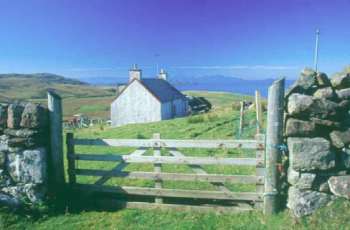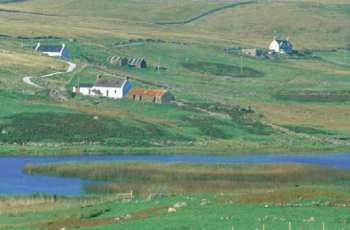1.3 CROFT & FARM LAND
Introduction
There are over 2,000 crofts in Sutherland, occurring
mostly in the west and north and covering 1,048km2, over one sixth of the
total land area. The greater part of this is hill ground used as common
grazings, but there is a narrow fringe of more fertile ground along the
coast, which was more widely cultivated in the past. Farmland is virtually
confined to the south-east and some of the more fertile straths throughout
the county. Actively managed agricultural land, where a mosaic of crops
are grown and mixture of sheep and cattle are grazed, is generally
considered to be good for biodiversity by providing a variety of habitats.

Croft at Culkein, Assynt
|
Biodiversity objectives
To encourage actively managed, small-scale agriculture such as
traditionally managed crofts and small farms for their environmental
and landscape benefits, and make the public aware of those benefits.
To enable up to 50% of
Sutherland’s farm and croft land to be managed for biodiversity under
agri-environment schemes such as the Rural Stewardship Scheme or
Whole-Farm Agreements.
To create genuine, accessible
economic benefits from biodiversity for those involved in agriculture.
To restrict or reduce the
year-round grazing of woodlands to assist natural regeneration.
|
Specific habitats discussed in Appendix 1
Rough grassland
Arable crops & field margins

Crofts at Clashmore, Assynt
|
Future actions:
Create and demonstrate genuine socio-economic benefits from
biodiversity by enhancing links with tourism and local marketing of
produce (the Highland Council, Highlands of Scotland Tourist Board,
Highlands & Islands Enterprise).
Raise public awareness of the
biodiversity benefits of well-managed croft and farm land, the
importance of traditional land management skills and the potential
impacts if this sort of agriculture continues to decline (Scottish
Natural Heritage, the Highland Council). |

Sheep grazing, Strathnaver
B. Lack of agri-environment funding
Issues: Agri-environment schemes such as the Rural Stewardship Scheme
provide some income for
biodiversity-friendly management, although such schemes have been
under-funded to date. Agricultural funding does not reflect the
institutional and social complexities of crofting areas, where crofters
may depend on a large area of common grazing and yet payments are area
based.
Neither does it take into account the annual
letting of land or the habitat diversity of common grazings.
Opportunities: Crofters and farmers could do a lot more positive
environmental works if the level of funding available through the Rural
Stewardship Scheme and whole farm agreements was enhanced, and the scoring
criteria amended to take account of small and rented units as well as
common land.
Current projects: The Scottish Crofting
Foundation and Scottish Natural Heritage run an award scheme incorporating
environmental criteria entitled ‘The Crofting Township of the Year Award’.
|
Future actions:
Enhance the Rural Stewardship Scheme so that it is more accessible and
delivers both for individuals and common grazings across the full
potential range of habitats (Scottish Executive Environment & Rural
Affairs Department).
Raise awareness of the options
available under the Rural Stewardship Scheme, and make it more
accessible for anyone going into crofting through the Croft Entrant
Scheme and for those keeping cattle in the North West (Scottish
Executive Environment & Rural Affairs Department, Crofters Commission,
Scottish Crofting Foundation, Scottish Agricultural College, Highland
Farming & Wildlife Advisory Group).
Develop more Peatland
Management Scheme type operations for areas not currently eligible on
other habitats (Scottish Natural Heritage). |
|
C. Decline in cattle numbers
Issues: The decline in numbers of hill cattle since the 1970s is
contributing to a reduction in the biodiversity of some grasslands,
moorlands and woodlands. Cattle grazing is often beneficial because of the
non-selective manner in which they graze and trample the ground. Sheep
have largely replaced cattle in crofting areas, and in-bye croft land is
often neglected or overgrazed. A continued decline in cattle, and the
associated loss in cropping, will have particularly adverse effects on the
area’s biodiversity.Opportunities:
Crofters and farmers should be encouraged to rear more cattle on an
extensive basis, altering the stocking densities according to the habitat
type.
Current projects: The North West Cattle
Producers Association is trying to raise awareness of the importance of
cattle for biodiversity, and to encourage crofters and farmers in North
West Sutherland to keep more cattle.

Cattle grazing below Suilven
Future actions:
Encourage farmers and crofters to rear more cattle in some areas,
where this will result in biodiversity benefits (North West Cattle
Producers Association & others).Raise
awareness of the link between cattle grazing and biodiversity through
demonstration sites (North West Cattle Producers Association &
others).
Extend the use of woodchip corrals and sheds,
to reduce winter poaching of in-bye land from overwintering cattle
(North West Cattle Producers Association, North Highland Forest
Trust).
Support the erection or repair of fences and
dykes to aid management of cattle on hill land (Scottish Executive
Environment & Rural Affairs Department, Scottish Natural Heritage). |
D. Loss of boundary features
Issues: Farms are getting bigger, and it is
no longer
viable to employ a large workforce to maintain hedgerows, dykes and other
features used by wildlife. This is leading to the loss and neglect of
hedges and drystone boundary walls in East Sutherland.
Opportunities: Training could be provided in
land
management skills such as drystone dyking, hedge
creation and management, and crofters and farmers
should be encouraged to undertake such works
where practical for biodiversity, shelter and stock
management benefits.
Current projects: Clashmore & Raffin
Township have produced a Development Plan that identifies a desire to
rebuild the existing historically important dykes for their biodiversity
benefits.
|
Future action:
Provide training courses on the management of boundary features such
as conservation headlands, hedges and ditches (Lantra, Highland
Agricultural Labour Supplies, Scottish Agricultural College and
Highland Farming & Wildlife Advisory Group). |
E. Intensification
Issues: Mechanisation and intensification of crop production is
leaving less waste on the fields. A reduction in crop rotation and decline
in the undersowing of cereal crops to produce a grass ley is leading to a
reduction in the diversity of management both across the farm and through
the year, leading to a corresponding reduction in biodiversity.
Nutrient enrichment from fertilisers can cause
problems far beyond the farm boundary, and widespread use of pesticides is
associated with the severe decline in populations of farmland birds,
largely due to the effects on their food supply, although this is less of
a problem in Sutherland than
elsewhere. Increased and insensitive use of sheepdips and cattle drenches
leads to a loss in invertebrates, and there are disposal issues with
sheep dip. The use of some broad spectrum antiparasitic drugs has reduced
the number and variety of insects associated with dung, which are
important as food for birds like starlings. Overgrazing of inbye croft
land by sheep is also reducing the biodiversity value of the grassland.
Opportunities: Facilitate nutrient budgeting
plans to help farmers utilise manure and reduce dependence on fertilisers.
Increase coverage of the Rural Stewardship Scheme to enable more farms and
crofts to gain entry to the scheme.
|
Future actions:
Encourage organic & low intensity farming (Scottish Agricultural
College, Highland Farming & Wildlife Advisory Group).
Encourage crofters and farmers
to create or manage existing wild flower meadows for their
biodiversity benefits, including invertebrates such as bumble bees,
butterflies & moths, (Scottish Natural Heritage, Scottish Agricultural
College, Highland Farming & Wildlife Advisory Group).
Encourage small local
contractors to spread farmyard manure and spent sheep dip on
designated areas (Scottish Environmental Protection Agency, Scottish
Agricultural College, Highland Farming & Wildlife Advisory Group). |

Orchid
|















